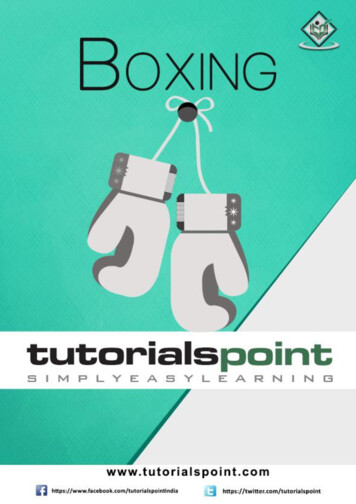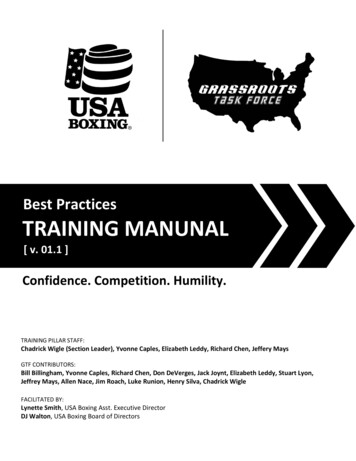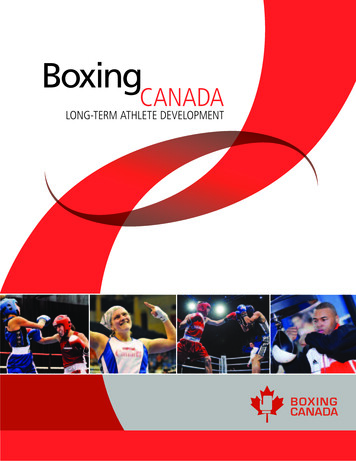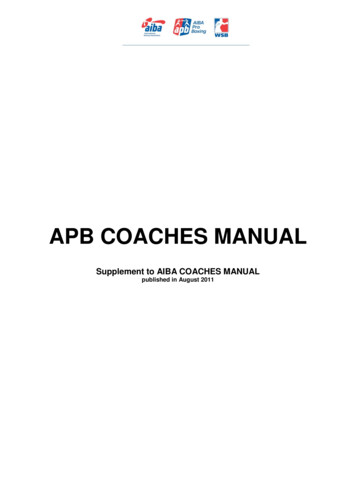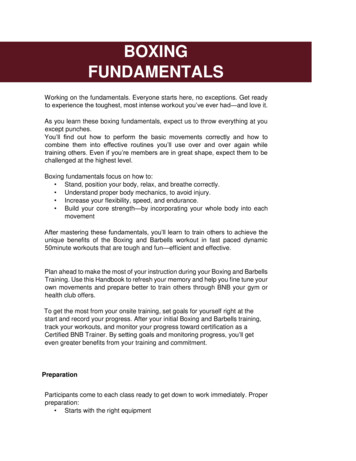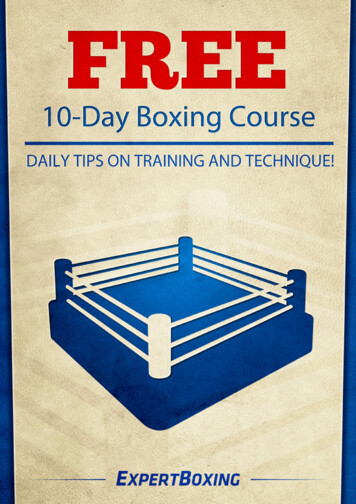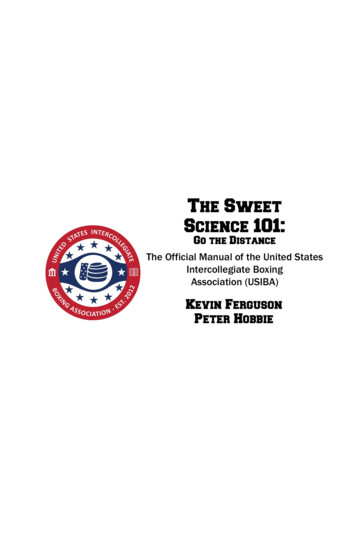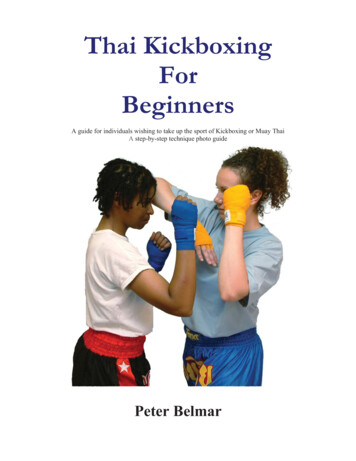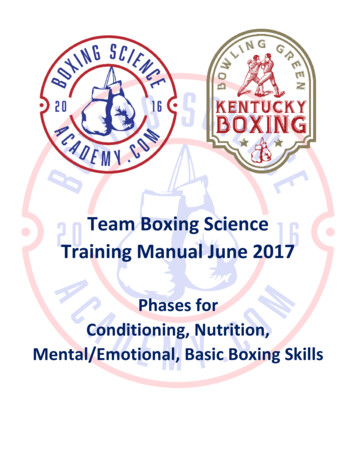
Transcription
Team Boxing ScienceTraining Manual June 2017Phases forConditioning, Nutrition,Mental/Emotional, Basic Boxing Skills
Page 1IntroductionThe Boxing Science Academy Training Manual and website are designed to give the at home boxer the best chance tolearn boxing if they cannot get to a gym with a real coach. You are given an annual plan similar to the kind used by thenational team of your country. The difference is, this one focuses on what is necessary for entry level athletes, and notfor seasoned international competitors.Whether you are young or old, masters or pee-wee (adult supervision is suggested for all youth), you are encouraged tograb a friend or family member, and go to the garage, basement or back yard, to learn the pugilistic art the way it wasintended; person on person.Even though the website does have a Members area, there is plenty of valuable and free information at the BoxingScience Academy, beginning with The Critical Frist Day page. Here you will find free books and videos focused on dayone of boxing. From there you will move onto the Lessons, Preparation and Trouble Shooting pages, browsing to find thepuzzle pieces needed to create your picture. There are approximately 150 videos to choose from. If you cannot findwhat you are looking for, try using the search tool at the top of every page. Simply type in a topic or key word, and strikeenter on your keyboard. When you are ready to get serious you will begin with Phase 1 – The 1st 4 Weeks.Members will appreciate the intermediate and advanced video lessons, as well as the progressive Phases for skilldevelopment. There are also Mental/Emotional phases and Nutrition phases for Members. Going to the individualBoxers pages will show you examples of how real people just like you travelled through their journey of drills from firstday technical sparring, to open sparring, to outside sparring, to possibly competition.HistoryA few years ago, I led the team of writers that created the USA Boxing Grassroots Training Manual, which is now themain resource for the USA Boxing Level 1 on-line coach certification exam. Our intention was to provide a tool for newcoaches to become better boxing trainers at the community and club level. After completing that assignment, I wasinspired to move forward in rejuvenating the sport of boxing. I believe the best place for this to happen is at the entrylevel. With a significant decrease in boxing participation over the past few decades, disappearing gyms have left less andless opportunity for the kid who wants to learn.I have been fortunate to learn boxing through old fashioned mentorship, from the old guys in rec centers that used totell stories about watching Joe Louis train, and how good Floyd Sr, James Toney, and Boom-Boom Johnson were whenthey were coming up.My plan was to find Small Town, USA (which turned out to be Bowling Green KY, USA), open a gym where there was noboxing, teach what I have learned, and film it as the team grew organically. The result is the Boxing Science Academywebsite. The truth is, a big ring, dozens of bags and tons of expensive equipment are not necessary to learn real boxing.It’s a person on person sport. All you need is another human being in front of you. Everything else is valuable, butsecondary. I filmed nearly 200 training days, for over a year, at the BGKY Boxing Club. I’ve organized the website in a waythat you can either search for specific lessons, or go through the suggested “phases”.WARNING: Boxing is a contact sport where injury and/or death may result. The information on BoxingScienceAcademy.com and associated materialsare intended for educational and instructional purposes only. Use at your own risk. Under 18 years old please use adult supervision if attempting any ofthese drills. Boxing is a physically demanding activity. Please check with your doctor before you begin any new sport or fitness program.
Page 2How to Use This ResourceThe foundation of your first-year plan is the progression of strength and conditioning. Everyone will have their ownjourney as they move through the Skill, Nutritional, and Mental/Emotional phases, but the conditioning durations arestrongly suggested. It won’t matter how much you understand, or are aware of the concepts of strength andconditioning, it will not help you get stronger or faster. You actually have to put the work in and do it. All the otherthemed phases are go at your own pace.This document is filled with hyperlinks (ex. Boxing Science Academy). When you hover your cursor over blue text with anunderline, and click it, you will either be taken to a page on the website, or another place in this document.You are provided with more tools than most beginners have available to them. Be patient and disciplined. Read thetraining manual and explore the Lessons, Preparation and Trouble Shooting pages inside the Boxing Science Academy.Give an enthusiastic friend or family member a copy of the training manual to download, and begin your pugilisticjourney as a team. I cannot reiterate this enough. The best way to learn real boxing is with another person.You can also consider asking one of your buddies (or family members) to be your coach, if you cannot find anyone to boxwith. Your coach can learn basic Focus Mitts (free and members) and support you in getting precise and accurate.When you are ready, begin in this order:Step 1 – Download and read this Manual (it may not all make sense now but a once over preview will be beneficial)Step 2 – Hang the basic boxing workout poster (free) in your gym areaStep 3 – Read and practice the Critical First Few Days (free) book and videosStep 4 - Begin with Phase 1 (member’s area) and the 1st 4 weeks of TrainingStep 5 – Come back to this manual and study how the other phases intertwineLastly, some of the information in this manual may seem a bit outdated and less romantic than the latest fads you seeon TV or the internet. Counting calories and using the Principle of Progression may seem less enticing than theneighborhood box gym using their Principle of Confusion, or the midnight infomercial’s suggestion for rapid weight loss.Most everything here (with conditioning and nutrition) will be found from many different resources. What wasintroduced in the 1980’s is now widespread practice for most athletic and fitness professionals. As a beginner, if youwould like to learn more about periodization, my recommendation is to pick up a book by Tudor Bompa, and NancyClark for nutrition.Now go get started. Good Luck, and see you in the ring,Coach Chadrick WigleWARNING: Boxing is a contact sport where injury and/or death may result. The information on BoxingScienceAcademy.com and associated materialsare intended for educational and instructional purposes only. Use at your own risk. Under 18 years old please use adult supervision if attempting any ofthese drills. Boxing is a physically demanding activity. Please check with your doctor before you begin any new sport or fitness program.
Page 3WARNING: Boxing is a contact sport where injury and/or death may result. The information on BoxingScienceAcademy.com and associated materialsare intended for educational and instructional purposes only. Use at your own risk. Under 18 years old please use adult supervision if attempting any ofthese drills. Boxing is a physically demanding activity. Please check with your doctor before you begin any new sport or fitness program.
Page 4Table of contentsIntroduction . . 1Big Plan Chart . 3Table of Contents . 4Conditioning 5Annual Plan (1st year boxer) . 7Conditioning Phases 8Nutrition . 10Some Basic Stuff About What to Eat and Why 11Basic Skills (excerpts from the Boxing Science Skills Guide) . 15Ready PositionJab (Straight Lead)Straight Rear Power PunchLead HookAppendix 20Phase Checklists 1.0Skill PhasesMental/Emotional PhasesNutritionResistanceChart 1.0 - Empty Annual Conditioning Plan . 22Instruction 1.0 – 1st Month . 23Instruction 2.0 – 2nd Month . 24Instruction 3.0 – 3rd Month . 25Journal 1.0 – General Prep . 26Journal 2.0 – Maximum Strength 27Journal 3.0 – Speed . 28NutritionJournal 4.0 – Common Foods 29Journal 5.0 – Daily Accounts . 30Diagram 1.0 – Food Guide Pyramid . 31Diagram 2.0 – Food Guide Plate . 32WARNING: Boxing is a contact sport where injury and/or death may result. The information on BoxingScienceAcademy.com and associated materialsare intended for educational and instructional purposes only. Use at your own risk. Under 18 years old please use adult supervision if attempting any ofthese drills. Boxing is a physically demanding activity. Please check with your doctor before you begin any new sport or fitness program.
Page 5ConditioningWARNING: Boxing is a contact sport where injury and/or death may result. The information on BoxingScienceAcademy.com and associated materialsare intended for educational and instructional purposes only. Use at your own risk. Under 18 years old please use adult supervision if attempting any ofthese drills. Boxing is a physically demanding activity. Please check with your doctor before you begin any new sport or fitness program.
Page 6ConditioningThe Conditioning portion of the manual refers to developing the cardiovascular, and musculature systems of your body.First item, go to the Appendix and print the Conditioning Annual Plan Chart 1.0, and fill in your dates with the monthyou are starting at the top of the far-left column and the day in the far-left of the top row. My suggestion is to not doany substantial conditioning the first month. All you must do is simply box, and practice your new skills, progressing andimproving. You’re here to learn how to box, so make that your focus. Months 2 and 3 will give you time to be an “entrylevel athlete” as you begin to work with basic exercises through stations/circuits. Use the guidelines in the appendix asyour starting tool and these Video Examples as supplementation resources.Basic Strength Circuit (bar mechanics with 25, build yourself, at home set)Basic Cinder Block CircuitBasic Low Weight CircuitOnce you are past the first couple of months consider investing into a better home gym, or monthly membership atfacility with weights/resistance tools. Until then, do what I have outlined here with the journal tools found in theAppendix.To get a better understanding of what your annual conditioning plan will look like see the example directly below, alongwith the summaries/charts to better explain what to do.WARNING: Boxing is a contact sport where injury and/or death may result. The information on BoxingScienceAcademy.com and associated materialsare intended for educational and instructional purposes only. Use at your own risk. Under 18 years old please use adult supervision if attempting any ofthese drills. Boxing is a physically demanding activity. Please check with your doctor before you begin any new sport or fitness program.
Page 7WARNING: Boxing is a contact sport where injury and/or death may result. The information on BoxingScienceAcademy.com and associated materialsare intended for educational and instructional purposes only. Use at your own risk. Under 18 years old please use adult supervision if attempting any ofthese drills. Boxing is a physically demanding activity. Please check with your doctor before you begin any new sport or fitness program.
Page 8Print the empty chart found in the Appendix Chart 1.0, and enter the dates as pertains to YOUR schedule (use theabove example as a reference). Remember to “black out” the dates in the months with less than 31 days. Use thematching journals for the list of exercises to use in each phase.General Preparation Phase: balanced health for musculature and skeletal (bones and joints) systems prepares body for overall conditioning before sport specific exercise non-stop circuits or high rep (20 ) sets working muscles on all sides of jointso still use failure/fatigue; add weight next day after achieving maximum reps allowed 10-15 exercises 3mi/5km roadwork (or cardio machine if you have lower body injuries, etc) for continuous aerobicTraining ParametersTraining Parameters for General Prep Phase Circuit Training (CT)Novice AthletesExperienced AthletesDuration of PhaseLoadNo. of stations per circuitNo. of circuits per sessionTotal time of CT sessionRest interval between exercisesRest interval between circuitsFrequency per week8-10 weeks30-40%9-12 (15)2-320-25 minutes90 seconds2-3 minutes2-33-5 weeks40-60%6-93-530-40 minutes60 seconds1-2 minutes3-4Maximum Strength Phase: Phase to train muscles/body to fire as many motor units as possible in each movement Use multi-joint movements with as many muscles as possible Use plyometrics to train ‘start’ power Higher weight (68-80% 1RM [one repetition with maximum weight]) less reps (0-5) and more sets 30 minutes roadwork (10 minute warm-up, 10 minutes repeating 100m sprint/walk back, 10 minute 60-80%continuous jog)Training Parameters for Maximum Strength Phase (MxS)Training ParametersWorkLoadNumber of ExercisesNumber of Repetitions per setNumber of sets per sessionRest intervalFrequency per week68-80%3-51-46-10 (12)3-6 minutes2-3 (4)WARNING: Boxing is a contact sport where injury and/or death may result. The information on BoxingScienceAcademy.com and associated materialsare intended for educational and instructional purposes only. Use at your own risk. Under 18 years old please use adult supervision if attempting any ofthese drills. Boxing is a physically demanding activity. Please check with your doctor before you begin any new sport or fitness program.
Page 9Speed Phase: Fast paced repetition drills for ‘reactive’ power and agility LOW weight (possibly less than what is used for competition), moderate number of high speed reps 30 minutes roadwork (10 minute warm-up, 10 minutes “light posts” [run to one light post 100%, next 50%;repeat], 10 minute 60-80% continuous jog)Training ParametersTraining Parameters for Speed (ballistic) TrainingWorkLoadNumber of ExercisesNumber of repetitions per setNumber of sets per sessionRest intervalSpeed of executionFrequency per weekLight (less than competition)2-510-203-52-3 minutesExplosive2-4Maintenance Phase: 3 off days opposite from boxing days using 1 day for general, 1 for maximum strength, 1 for speedo Use 60% of your workload (Ex. General phase – instead of 3 sets of bench press of 100lbs @ 20 reps do 3 sets of 60lbs; Speed Phase – instead of 3 sets of 10 squat jumps do 3 sets of 6 squat jumps; etc)WARNING: Boxing is a contact sport where injury and/or death may result. The information on BoxingScienceAcademy.com and associated materialsare intended for educational and instructional purposes only. Use at your own risk. Under 18 years old please use adult supervision if attempting any ofthese drills. Boxing is a physically demanding activity. Please check with your doctor before you begin any new sport or fitness program.
P a g e 10NutritionWARNING: Boxing is a contact sport where injury and/or death may result. The information on BoxingScienceAcademy.com and associated materialsare intended for educational and instructional purposes only. Use at your own risk. Under 18 years old please use adult supervision if attempting any ofthese drills. Boxing is a physically demanding activity. Please check with your doctor before you begin any new sport or fitness program.
P a g e 11Nutrition Guidelines(this is similar to the document I send to the BGKY Boxing Team)Here are some general nutrition tips regarding weight loss and maintenance.Step 1Keep a journal for a week (see below Observe-Evaluate-Implement a New Plan)Step 2Pick a desired weight (class). If you want to lose a lot of weight consider that a healthy drop is about 1-2lbs per week, or8-10lbs per month. Pick from column A of the weight class table. (Editor’s Note: As of this document posting on theBoxing Academy website, June 2017, AIBA just announced two new weight categories for females, and the plans toreduce the amount of men’s categories for the 2020 Olympics. We have not been told what the new weights for themen will be, therefore some of the weights in the charts will not be accurate or relevant by the time you read this. As abeginner “at-home” boxer simply concern yourself with getting to a healthy, manageable and effective weight [you canstill use the below chart for a base level guideline], getting used to boxing and the rest will fall together when it needsto.)Step 3What does your average daily activity/expenditure look like (remember that your exercise/training is separate)? Sittingat a desk might be Low, a mechanic or active mother Moderate, and a lumberjack or construction worker High. Note:often when a person has high activities they have a low lifestyle.Step 4Plan your day accordingly whether it’s a light day, a regular day without exercise, a conditioning day or a boxing day.Schedule your meals to handle your base calorie needs, and if you plan to exercise, consider having either a pre or posttraining snack that accounts for the calories you burn during the activity.----Observe – Evaluate – Implement a New PlanLet’s say you know there’s something wrong with your car and take it to the mechanic. First thing they’ll have todo is diagnose the problem. No different here. First, before any kind of diet, look at what is really going in and out ofyour body. Keep a journal for at least a week, making notes of everything going in (foods, calories, water,carbs/proteins/fats, etc.) and going out (waste, calories burned during exercise, water). The trick is to not judge youractions and keep going as you normally would. Notice your deficiency in whole foods, and patterns like survival eating atnight because you’ve been busy most of the day and gone without food. Also begin to quantify the foods you regularlyeat (example: how many calories, g protein, g carbs, g fats in a piece of bread) so you have a quick reference and moreaccurately knowledgeable understanding of what you are ingesting.When to Eat King - Prince - Pauper Eat your largest number of calories in the morning (bigger breakfast, medium lunch, and less at night). Snacks Add snacks accordingly to your day. For example, if you are a boxer striving towards a weight class of165lb then plan for a snack after your boxing workout taking in the same number of calories you justburned at practice. If you don’t train or practice on a particular day, then all of your calories come fromyour basic daily allowance.WARNING: Boxing is a contact sport where injury and/or death may result. The information on BoxingScienceAcademy.com and associated materialsare intended for educational and instructional purposes only. Use at your own risk. Under 18 years old please use adult supervision if attempting any ofthese drills. Boxing is a physically demanding activity. Please check with your doctor before you begin any new sport or fitness program.
P a g e 12Calorie Intake by Weight ClassNote: a healthy diet for a weight class athlete is 60%/20%/20% : carbs/protein/fatsExample: how to read the table below; find your goal weight class112 (f) 1120 cal 1456 218/73/32 1680 252/84/38 1904 286/95/42Meaning a 112lb female needs 1120cal to simply exist. If she has low activity outside of purposeful exercise add 336cal,for a total of 1456 calories. Using 4cal per gram of both protein and carbs, and 9cal per gram of fats; 218g of carbs, 73gof protein, 32g of fat.AWeight Class (lb)112 (f)132 (f)165 (f)108 (m)114 (m)123 (m)132 (f)140 (m)152 (m)165 (m)178 (m)200 (m)225 (200 )BRest Met Rate1120 0CLow Activity 30% g of Carbs/Pro/Fats1456 218/73/321716 282/86/382145 322/107/481404 210/70/311482 222/74/331599 240/80/361716 282/86/381820 273/91/401976 297/99/442145 322/107/482314 347/116/512600 390/130/582925 439/146/65DMod Activity 50% g of Carbs/Pro/Fats1680 252/84/381980 297/99/442475 371/124/551620 243/81/361710 256/86/381845 277/92/411980 297/99/442100 315/105/472280 342/114/512475 371/124/552670 400/134/593000 450/150/673375 506/169/75EHigh Activity 70% g of Carbs/Pro/Fats1904 286/95/422244 337/112/502805 421/140/621836 275/92/411938 291/97/432091 314/105/462244 337/112/501380 357/119/532584 388/130/572805 421/140/623026 454/151/673400 510/170/763825 574/191/855 Nutrients Water (0cal/g) Vitamins/Minerals (0cal/g) Carbohydrates (4cal/g) – initial fuel for muscles, quickest to process Carbs are basically Simple (quick) or Complex (slow). Simple sugars will enter the blood stream quickly(spike), and complex carbohydrates take longer (gradual). We need carbohydrates for fuel, but an excesswill turn to fat, for storage when our bodies might need it. Food sources are fruits, vegetables, grains and starches Proteins (4cal/g) – builds/repairs muscle structure, medium time to process, last fuel source Found in meats, poultry, fish Fats (9cal/g) – quickly stored in body reserves, takes longer to process, fuel for longer activities Trans Fats – eliminate completely; commercial prepackaged baked goods/snacks, fried foods, pre-mixedproducts (cakes, etc), anything “partially hydrogenated” Saturated Fats – moderate intake; preferred from high quality sources of meats/dairies Monounsaturated Fats – “good” fats including avocados, olives, most nuts, natural peanut butter Polyunsaturated Fats – “good fats including walnuts, flaxseed, fish, soymilk/tofu, Omega-3’s Alcohol (7cal/g) – Note: NOT a nutrient but does contain caloriesWARNING: Boxing is a contact sport where injury and/or death may result. The information on BoxingScienceAcademy.com and associated materialsare intended for educational and instructional purposes only. Use at your own risk. Under 18 years old please use adult supervision if attempting any ofthese drills. Boxing is a physically demanding activity. Please check with your doctor before you begin any new sport or fitness program.
P a g e 13Energy Systems(NOTE: this energy section is not important for you to understand about “nutrition”. It may be a bit confusing. You don’t need to KNOW it. I believeit has value to explain why we need certain foods over another, and how those energy sources (food) are used for fuel. Ex. “The Atkins diet says notto eat carbs, but you suggest 60% from carbs. Why?” This energy section is the answer to why, because most of our activities use carbs for fuel.)Energy is needed to perform work/create force for muscular contraction. Foodstuff is converted into a highenergy compound known as adenosine triphosphate (ATP) which is stored in muscle cells Anaerobic Alactic AN (without) AEROBIC (oxygen) A (without) LACTIC acid Also known as: ATP-CP system ATP is used from small amount in muscle stores and with creatine phosphate (CP) Approximately 0-10 seconds of intense work Anaerobic Lactic AN (without) AEROBIC (oxygen) (with) LACTIC acid Also known as Lactic Acid system Glycogen (sugars stored in muscles) is used to create ATP, with lactic acid being a by-product Approximately up to 40-70 seconds of intense activity Aerobic (with) AEROBIC (oxygen) Sometimes referred to as “cardio” because the cardiorespiratory system is used to provide oxygen tobreakdown glycogen, fats, proteins, with byproducts of carbon dioxide and water through sweat andexhalation Fuel duration 40sec-25min is glycogen (sugars) 25min-2hr is fat 2hr is protein System Overlap It is not a clean line with time. Two systems will overlap as fuel sources transition from one to anotherdepending on duration and intensity Anaerobic Threshold The point where the anaerobic and aerobic systems meet Some studies suggest this occurs at 60-70 seconds (Keul, Doll, Keppler 1969) A good indicator can also be heart rate with higher levels being anaerobic ( 170bpm) and aerobic lower( 168bpm) System TrainingENERGY SYSTEMS AND TRAINING-PROGRAM VARIABLESTRAINING PROGRAM VARIABLESENERGY SYSTEMANAEROBIC alsIntervalsContinuousIntervalsActivitySport relatedSport relatedAlternativesSport relatedIntensityMax speed/effortNear max60-70% VO2 max 85-95% VO2 maxWork time 10 sec15sec-2min20-60 minutes10sec-3minWork/Pause ratio1:5 or 1:61:5 to 1:61:2Sets/set volume 60 sec 3 min3-5 minRest between sets3-10 min10-15 min10-15 minTotal work volume2-3 min max 12 min15-60 min15-60 minTraining period8-12 weeks8-12 weeks8-12 weeks8-12 weeksFrequencyHard-easy (48hr)Hard-easy (48hr) DailyHard-easy (48hr)WARNING: Boxing is a contact sport where injury and/or death may result. The information on BoxingScienceAcademy.com and associated materialsare intended for educational and instructional purposes only. Use at your own risk. Under 18 years old please use adult supervision if attempting any ofthese drills. Boxing is a physically demanding activity. Please check with your doctor before you begin any new sport or fitness program.
P a g e 14Calories Expenditure for Common Boxer Activities(values were calculated based on a chart from the Nutri Strategy website)ActivityBGKY Boxing Drills Class, rope & sparBGKY Boxing Conditioning ClassBGKY Boxing Fitness ClassBoxing, in ringBoxing, punching bag, lightBoxing, punching bag, vigorousBoxing, SparringJumping rope, fastJumping rope, moderateJumping rope, slowRunning, generalCalisthenics, vigorousCalisthenics, lightCircuit training, minimal restHealth Club exerciseStretching-mildSwimming, fastSwimming, 633.633.631.593.632.491.144.543.18WARNING: Boxing is a contact sport where injury and/or death may result. The information on BoxingScienceAcademy.com and associated materialsare intended for educational and instructional purposes only. Use at your own risk. Under 18 years old please use adult supervision if attempting any ofthese drills. Boxing is a physically demanding activity. Please check with your doctor before you begin any new sport or fitness program.
P a g e 15Basic Skillsexcerpts fromBoxing Science Skills Book:A Reference Guide for Boxing BeginnersWARNING: Boxing is a contact sport where injury and/or death may result. The information on BoxingScienceAcademy.com and associated materialsare intended for educational and instructional purposes only. Use at your own risk. Under 18 years old please use adult supervision if attempting any ofthese drills. Boxing is a physically demanding activity. Please check with your doctor before you begin any new sport or fitness program.
P a g e 16WARNING: Boxing is a contact sport where injury and/or death may result. The information on BoxingScienceAcademy.com and associated materialsare intended for educational and instructional purposes only. Use at your own risk. Under 18 years old please use adult supervision if attempting any ofthese drills. Boxing is a physically demanding activity. Please check with your doctor before you begin any new sport or fitness program.
P a g e 17WARNING: Boxing is a contact sport where injury and/or death may result. The information on BoxingScienceAcademy.com and associated materialsare intended for educational and instructional purposes only. Use at your own risk. Under 18 years old please use adult supervision if attempting any ofthese drills. Boxing is a physically demanding activity. Please check with your doctor before you begin any new sport or fitness program.
P a g e 18WARNING: Boxing is a contact sport where injury and/or death may result. The information on BoxingScienceAcademy.com and associated materialsare intended for educational and instructional purposes only. Use at your own risk. Under 18 years old please use adult supervision if attempting any ofthese drills. Boxing is a physically demanding activity. Please check with your doctor before you begin any new sport or fitness program.
P a g e 19WARNING: Boxing is a contact sport where injury and/or death may result. The information on BoxingScienceAcademy.com and associated materialsare intended for educational and instructional purposes only. Use at your own risk. Under 18 years old please use adult supervision if attempting any ofthese drills. Boxing is a physically demanding activity. Please check with your doctor before you begin any new sport or fitness program.
P a g e 20AppendixWARNING: Boxing is a contact sport where injury and/or death may result. The information on BoxingScienceAcademy.com and associated materialsare intended for educational and instructional purposes only. Use at your own risk. Under 18 years old please use adult supervision if attempting any ofthese drills. Boxing is a physically demanding activity. Please check with your doctor before you begin any new sport or fitness program.
P a g e 21Checklist 1.0Skill PhasesPhase 1 – 1st 4 WeeksPhase 2 – Jab DrillsPhase 3 – Straight Rear DrillsPhase 4 – Straight Body ShotsPhase 5 – Lead HookPhase 6 – CountersPhase 7 – Southpaw & OppositesPhase 8 – AnglesPhase 9 – Uppercuts & Short ShotsPhase 10 – Short Body ShotsMental/Emotional PhasesPhase A. Goal SettingPhase B. Meditation/Relaxation CuesPhase C. Self-ObservationPhase D. Positive Self-TalkPhase E. Opponent ObservationPhase F. Focus CuesPhase G. Power PhrasePhase H. Anxious DialPhase I. Pre-Game RitualsPhase J. VisualizationPhase K. Highlight ReelPhase L
training manual and explore the Lessons, Preparation and Trouble Shooting pages inside the Boxing Science Academy. Give an enthusiastic friend or family member a copy of the training manual to download, and begin your pugilistic journey as a team. I cannot reiterate this enough. The best way to learn real boxing is with another person.File Size: 2MB
